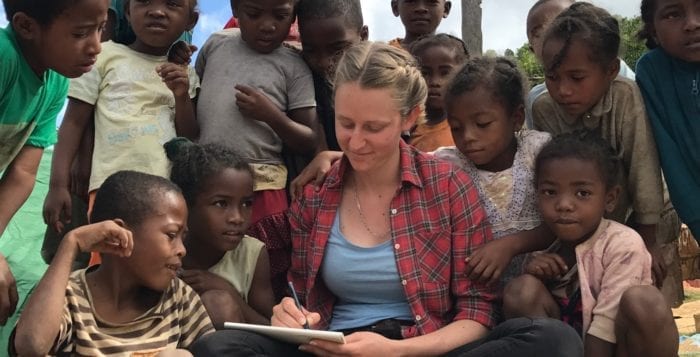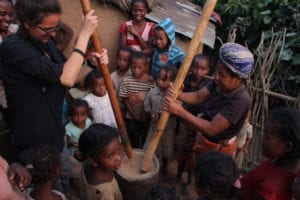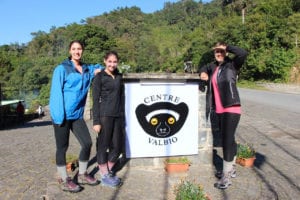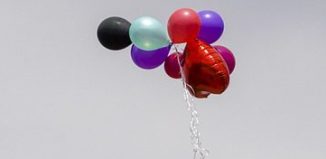Laurel Hollow team partners with Stony Brook University in Madagascar

By Daniel Dunaief
Mickie Nagel recently returned from the island nation of Madagascar, and she’s filled with ideas, inspiration, observations and opportunities. One of the three founders of a new nongovernmental organization called BeLocal, the Laurel Hollow resident spent several weeks with Stony Brook University graduate students Leila Esmailzada and Acacia Leakey taking videos and gathering information about life in Madagascar.
The goal of the new organization is to share this footage and insight with undergraduate engineers at SBU, who might come up with innovations that could enhance the quality of life for the Malagasy people.
In one village, a man showed her a three-inch lump on his shoulder, which he got by dragging a long stick with bunches of bananas that weigh over 100 pounds along a clay footpath out of the forest. People also carry rice that weighs over 150 pounds on their heads, while many others haul buckets of water from rivers and streams to their homes while walking barefoot.
In addition to transportation, Nagel also found that villagers around Centre ValBio, a Stony Brook research station, had basic food and water needs. Over 17 years ago, another group had installed four water pumps in a village to provide access to water. Only one pump now works.

As for food, some villagers in Madagascar spend hours preparing rice, including beating off the husks and drying the rice. They store this hard-earned food in huts that are often infiltrated with rats, who consume their rice and leave their feces, which spreads disease.
Traveling with Esmailzada and Leakey, Nagel not only helped document life in these villages but also searched for information about available resources to drive engineering innovations, while Leakey gathered information about an invasive species of guava.
“Ideally, if any projects require wood, then they should incorporate guava sticks into their design, as opposed to planks from forest trees,” explained Leakey in an email sent from Madagascar. The graduate student, who recently earned her bachelor’s degree at Stony Brook, will be recording the average thickness of the stems, the average length of a straight piece and the load capacity of the branches. Leakey plans to return from the African continent in the beginning of August.
Leakey also visited metalworkers to explore the local capacity. The raw materials come from scrap metal dealers, who often get them from old car parts.
Nagel started BeLocal with her husband Jeff Nagel and a classmate of his from their days as undergraduates at Carnegie Mellon University, Eric Bergerson. Indeed, BeLocal fulfills a long-standing goal of Jeff Nagel’s. Before freshman year in college, Nagel told Bergerson that he wanted to do something that had a positive impact on the world.
While the founders have contributed through their work, their jobs and their families, they found that partnering with Stony Brook University and Distinguished Professor Patricia Wright in Madagascar presented a chance to have a meaningful impact on life on the island nation.
Nagel, whose background is in marketing, visited Madagascar over two years ago, where she traveled for over a hundred hours on a bus through the country. “You just see people living below the poverty line and you see how that plays out in normal day-to-day activities,” she said. “You see a young mom carrying a child on her back and one on her front, with heavy produce on her head and you just think, ‘Wow, there has to be an easier way for some of this.’”

When Nagel returned from her initial trip to Madagascar with her daughters Gabrielle, 18, and Lauren, 17, she and her husband thought people around the world would likely want to help but that not everyone could afford to travel that far.
Nagel recalls Bergerson, who is the director of research at the social data intelligence company Tickertags, telling her that they “don’t have to travel there. You can videotape the daily challenges and crowd source” innovations.
That’s exactly what Leakey and Esmailzada did for the last few weeks. Leakey said she is looking forward to working with senior design students as they go through their projects at Stony Brook and is eager to see how they understand the situation “through the footage and pictures we collect.”
The BeLocal approach isn’t limited to Madagascar, the BeLocal founders suggested. Indeed, given the distance to an island famous for its lemurs, animated movies and an Imax film that features primates with personality, BeLocal could have started in a Central American country like Belize.
Mickie Nagel, however, urged them to start at a location where they would immediately have the trust of local residents. That, she suggested, came from the over quarter of a century of work from Wright, an award-winning scientist who has not only helped preserve Ranomafana [National Park in Madagascar] but has also helped bring health care and education to the villages around the CVB research station. Wright and the Malagasy people have a “mutual respect for each other,” Nagel said.
“People have been exceptionally warm and welcoming,” Leakey said. Getting people accustomed to the presence of cameras hasn’t been straightforward, as people sometimes stop what they are doing, but the guides have helped make the villagers more comfortable.
Jeff Nagel, who works at a private equity firm in New York City, explained that Madagascar is the first step for BeLocal. This effort “can be expanded to other countries or other areas,” Nagel said. “It doesn’t have to be engineers and universities,” but can be instituted by creative people everywhere.
At this point, BeLocal is not looking for any additional funding but might consider expanding the effort at this time next year. Nagel said this fall, they will look for professional engineers to advise on projects. “We would like people who are interested in participating or just keeping up with developments to come and register on our website, www.BeLocalgrp.com,” she suggested.
The site, which the group is upgrading, is up and running. Bergerson explained that they have a “lot of infrastructure to build on” to create the crowd sourcing platform.
Jeff Nagel suggested that this effort is designed to use technology constructively. “Technology’s job, first and foremost, is to help humanity,” he said. “This is a chance to use it in a way that matters to people.”






